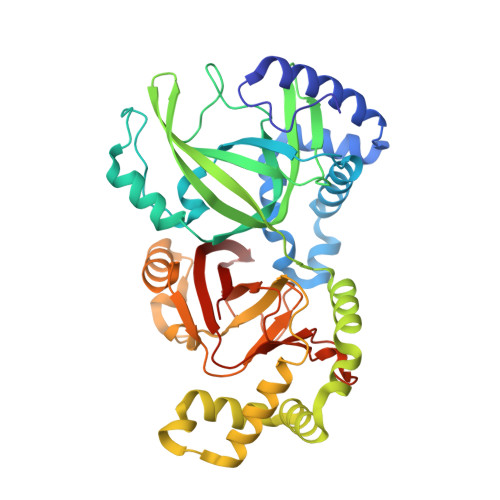Crystal Structure and Site-directed Mutagenesis of Enzymatic Components from Clostridium perfringens Iota-toxin
Tsuge, H., Nagahama, M., Nishimura, H., Hisatsune, J., Sakaguchi, Y., Itogawa, Y., Katunuma, N., Sakurai, J.(2003) J Mol Biology 325: 471-483
- PubMed: 12498797
- DOI: https://doi.org/10.1016/s0022-2836(02)01247-0
- Primary Citation of Related Structures:
1GIQ, 1GIR - PubMed Abstract:
Iota-toxin from Clostridium perfringens type E is an ADP-ribosylating toxin (ADPRT) that ADP-ribosylates actin, which is lethal and dermonecrotic in mammals. It is a binary toxin composed of an enzymatic component (Ia) and a binding component (Ib). Ia ADP-ribosylates G-actin at arginine 177, resulting in the depolymerization of the actin cytoskeleton. Here, we report on studies of the structure-function relationship by the crystal structures of Ia complexed with NADH and NADPH (at 1.8 A and 2.1 A resolution, respectively) and mutagenesis that map the active residues. The catalytic C-domain structure was similar to that of Bacillus cereus vegetative insecticidal protein (VIP2), which is an insect-targeted toxin, except for the EXE loop region. However, a significant structural difference could be seen in the N-domain, which interacts with Ib, suggesting an evolutionary difference between mammalian-targeted and insect-targeted ADPRT. The high resolution structure analysis revealed specific NAD conformation (a ring-like conformation of nicotinamide mononucleotide (NMN)) supported by Arg295, Arg296, Asn335, Arg352 and Glu380. Additionally, the mutagenesis study showed that the residues Tyr251, Arg295, Glu301, Ser338, Phe349, Arg352 and Glu380, including a newly identified one, are essential for NAD(+)-glycohydrolase (NADase) activity. At least one residue, Glu378, is an essential residue for ADP-ribosyltransferase (ARTase), but not for NADase. Consequently, the structural feature and these mutagenesis findings suggest that the catalytic mechanism of Ia proceeds via an Sn1-type reaction.
- Institute for Health Sciences, Tokushima Bunri University, Yamashiro-cho, Tokushima 770-8514, Japan. tsuge@tokushima.bunri-u.ac.jp
Organizational Affiliation:

















